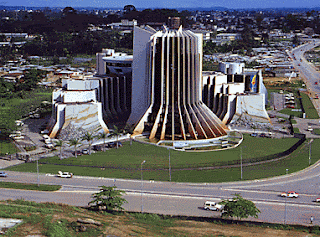Libreville is the capital and largest city of Gabon. The city is a port on the Komo River, near the Gulf of Guinea, and a trade center for a timber region. As of 2005, it has a population of 578,156.
Geography
From north to south, major districts of the city are the residential area Batterie IV, Quartier Louis (known for its nightlife), Mont-Bouët and Nombakélé (busy commercial areas), Glass (the first European settlement in Gabon), Oloumi (a major industrial area) and Lalala, a residential area. The city’s port and train station on the Trans-Gabon Railway line to Franceville lie in Owendo, south of the main built-up area. Inland from these districts lie poorer residential areas.
Climate
Libreville features a tropical monsoon climate with a lengthy wet season and a short dry season. Libreville’s wet season spans about nine months (September through May), with a heavy amount of rain falling during these months. The city’s dry season lasts from June through August where on average a total of about 35 mm of precipitation falls. As common with many cities with this climate, average temperatures remain relatively constant throughout the course of the year, with average high temperatures at around 30 °C (86.0 °F) .
Languages
Libreville is, with Abidjan, Ivory Coast, one of a few African cities where French is becoming a true native language, with some local features.
Economy
The city is home to a shipbuilding industry, brewing industry and sawmills. The city exports raw materials such as wood, rubber and cocoa from the city's main port, and the deepwater port at Owendo.
Gabon Airlines has its headquarters in Libreville. Prior to their dissolutions, both Air Gabon and Gabon Express were headquartered on the grounds of Libreville International Airport.
Notable residents
Daniel Cousin, football player who plays for Larissa FC and the Gabon national team, of which he is the captain and all-time top scorer.
Transport
Libreville International Airport is the largest airport in Gabon and is located around 11 kilometers (7 mi) north of the city.
Culture and education
Sights in Libreville include:
the National Museum of Arts and Traditions
the French cultural centre
St Marie’s Cathedral, seat of the Roman Catholic Archdiocese of Libreville
the carved wood church of St Michael, Nkembo
the Arboretum de Sibang
two cultural villages.
Libreville's main market lies in Mont-Bouët. Gabon's school of administration and school of law are in Libreville. Libreville also hosts the Omar Bongo University (est. 1970), various research institutes and a library. Alongside the Komo estuary is the Pongara National Park of 929 km2. Behind Cap Esterias is Akanda National Park, famed for its large congregations of migrating waterbirds.
The city is served by Libreville Hospital.
History
The area was inhabited by the Mpongwé tribe long before the French acquired the land in 1839. In 1846, L'Elizia, a Brazilian ship carrying slaves for sale, was captured by the French navy near Loango. The slaves were freed and founded Libreville (French for "Freetown") in 1848. It was the chief port of French Equatorial Africa from 1934 to 1946 and was the central focus of the Battle of Gabon in 1940.
Libreville was named in imitation of Freetown and grew only slowly as a trading post and a minor administrative centre to a population of 32,000 on independence in 1960. It only received its first bank branch when Bank of West Africa (BAO) opened a branch in 1930. Since independence, the city has grown rapidly and now houses nearly half the national population.


No comments:
Post a Comment